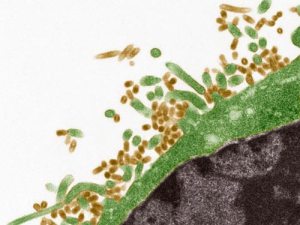It’s funny how reading these articles is incredibly relieving for me. They confirm that I actually did learn and do remember principals and details from my classes. Today’s article comes from Veterinary Research, and discusses the mechanisms and variables involved in the emergence of a virus.
” A viral emergence is generally defined as the appearance of a new pathogen for a host, such as human immunodeficiency virus (HIV)-1 for humans in the twentieth century. Viral re-emergence often refers to the reappearance of a viral pathogen after a period of absence, such as the periodic human influenza epidemics or pandemics.” (Domingo, 2010)
There’s a huge amount of information on viral evolution and mutation, a concept that (like everythin g else you haven’t specifically studied) I had greatly oversimplified. It was incredibly fascinating to read how viruses can recombine and splice gene segments from other unrelated infections, and the various pathways new genes can be created or introduced that allow viruses to jump host species. I’m not going to try to summarize all of those, the article explains them much better than I could, but there’s still a few broad topics in the paper worth discussing.
g else you haven’t specifically studied) I had greatly oversimplified. It was incredibly fascinating to read how viruses can recombine and splice gene segments from other unrelated infections, and the various pathways new genes can be created or introduced that allow viruses to jump host species. I’m not going to try to summarize all of those, the article explains them much better than I could, but there’s still a few broad topics in the paper worth discussing.
The concept of viral quasispecies is something I’ve never heard about. I’ve discussed viral serovars on here before, but I believe that term specifically refers to antigen variation. Quasispecies refers to groups of virus that are labeled and operate as one species (for example, Influenza H1N1) but contain different genomes. For example, if I get the flu this winter, the virus I am exposed to may contain several quasispecies, that are the same virus, but contain different genes. Now any deleterious mutations or reassortments will probably be wiped out by my immune system, but the ones with a fitness advantage will reproduce and take over. Here’s the extra interesting part, even if I had been infected with just one quasispecies, I could still shed several while I’m infected. There is so much mutation and variation in viral reproduction that I would be generating new ones as a single host.
Quasispecies are important in emergence because they are a major source of viral evolution. We identify the “wild type” gene amongst quasispecies as a distribution of genes that characterize that viral species (consensus gene); even though amongst different quasispecies they may be found in different places in the genome. This is where the existence of quasispecies propels viral evolution forward. When you mix up the genome so much, you can create mutations that change nothing in the functional portions of the genome, but create subpopulations that are fine tuned to conditions that may not yet be occurring. As an example, it’s been assumed that SARS was introduced to humans through Civet cats, when it was originally a virus transmitted by bats. Contact with civets is common in areas surrounding SARS outbreaks (where they are raised for food), where contact with bats is much less common. It is possible that there was a quasispecies subpopulation of SARS carrying a mutation allowing it to jump species to humans long before it was even introduced to civets. When the disease was contained to bats, this mutation has no fitness advantage, but it can sit idle until a change in the environment (higher infection rates in civets, civets brought from more rural areas, there are unlimited possibilities) gives it an advantage. This essentially allows virus to be proactive in its evolution. Instead of waiting for selective pressure, new genes are created spontaneously in the event that they may become useful.

The article continued to discuss different factors in emergence, primarily focusing on new host emergence, and brought it all together as an example of biological complexity. My personal favorite example for biological complexity is the realization that we’ll probably never fully understand the complete pharmacology associated with feelings of hunger and satiety. Alternatively you can illustrate this principal by asking someone to model the weather. The idea is that there are so many variables, all interdependent on each other, that it is pretty much impossible to trace all of the factors that led to an event such as the host change SARS made from civets to humans. They illustrate this by showing that even if viral variation is sufficient to promote a host change, there are numerous other roadblocks that have to be surmounted to allow it to take place (interaction with the new host, sufficient amounts of virus introduced to the system of the new host, fitness of the mutated virus, exposure to multiple quasispecies or serovars, future shedding of virus adapted to that host species, etc.). It’s a paradoxal idea, because we have been able to successfully model systems like these through the CDC and WHO, and we have been able to successfully model complex systems like the weather, even when there are countless interactions that we can’t even begin to measure.
Read this article if you have any interest in virology at all. I learned a lot, and it’s interesting and fluid reading if you have a basic understanding of cell biology.
![]() Domingo, E. (2010). Mechanisms of viral emergence Veterinary Research, 41 (6) DOI: 10.1051/vetres/2010010
Domingo, E. (2010). Mechanisms of viral emergence Veterinary Research, 41 (6) DOI: 10.1051/vetres/2010010


Just wanted to give a shout-out to ya for a great article! I spent the summer in Newport, OR at the Hatfield Marine Science Center, and a bit of time in Corvalis, as well. Way to represent OSU with the fine science article write-up! 🙂
TTFN
Darin